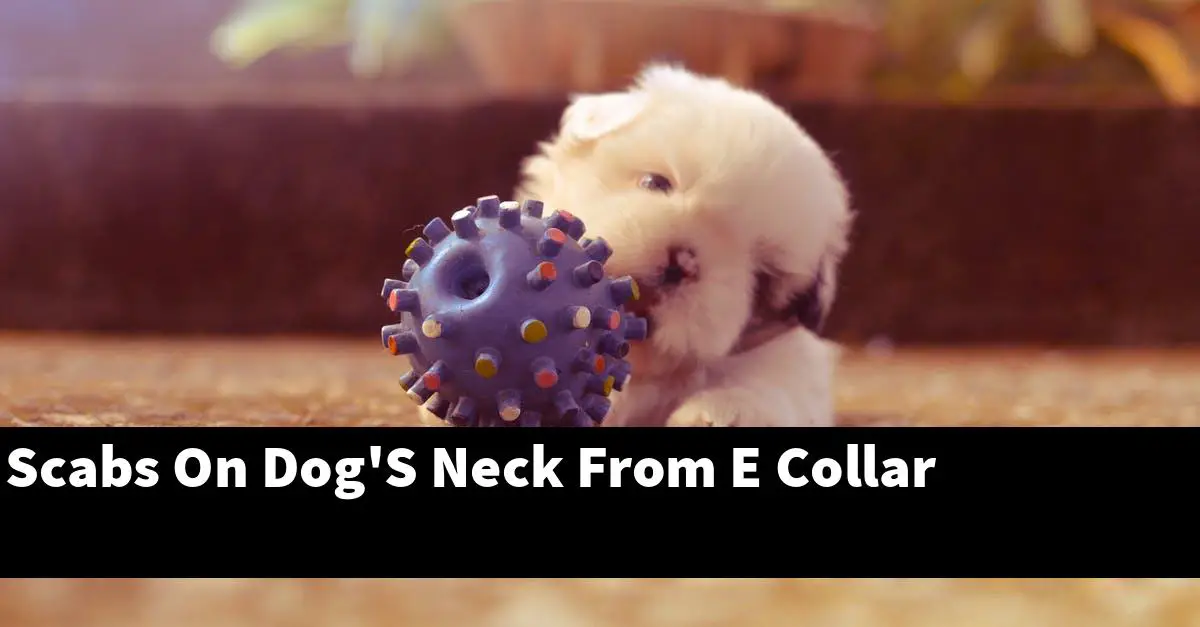A dog may develop scabs on its neck from wearing an e-collar, also known as an Elizabethan collar. An e-collar is a plastic or fabric cone that is placed around a dog’s neck to prevent it from licking or scratching a wound.
The article is going to be covering how to remove scabs on a dog’s neck from an e collar.
Table of Contents
What are scabs on a dog’s neck from an e-collar?
A scab on a dog’s neck from an e-collar is a result of the e-collar rubbing against the dog’s skin. The e-collar can cause irritation and inflammation of the skin, which can lead to the formation of a scab. Scabs can be uncomfortable for dogs and can cause them to scratch or bite at the area. If the scab becomes infected, it can be difficult to treat and may require antibiotics.
How can you prevent scabs on a dog’s neck from an e-collar?
One of the best ways to prevent scabs on a dog’s neck from an e-collar is to keep the area clean and dry. You can do this by wiping the area with a damp cloth or using a mild soap. It’s also important to avoid getting the area wet, so make sure the e-collar is dry before putting it on your dog. If the area does get wet, dry it off as soon as possible.
Another way to prevent scabs is to put the e-collar on your dog for only a short period of time. If you need to leave the e-collar on for longer periods, you can try putting a thin layer of petroleum jelly on the area. This will help to keep the skin moist and will reduce the risk of scabs.
If your dog does develop scabs, you can treat them with a topical antibiotic ointment. Apply the ointment to the scabs and then cover the area with a bandage. Be sure to change the bandage daily and to keep the area clean and dry. If the scabs don’t seem to be healing, or if they become infected, you should take your dog to the vet.
What are the causes of scabs on a dog’s neck from an e-collar?
Scabs on a dog’s neck can be caused by a number of things, but the most common cause is an e-collar. E-collars are often used to keep dogs from licking or scratching at wounds, but if they are not used properly, they can cause irritation and lead to scabs. Other potential causes of scabs on a dog’s neck include allergies, infections, and hot spots.
How can you treat scabs on a dog’s neck from an e-collar?
If your dog has scabs on his neck from an e-collar, there are a few things you can do to treat them. First, try to remove the e-collar as much as possible. This will allow the scabs to start healing. You can also use a warm compress to help soothe the area and speed up healing. Be sure to keep the area clean and dry, and apply a generous amount of moisturizer to keep the skin from drying out. If the scabs seem to be getting worse, or if your dog is in a lot of discomfort, it’s best to consult your veterinarian.
Can shock collars cause scabs?
Yes, in some cases, shock collars can cause scabs. This is usually due to improper fit or placement of the collar. Shock collars work by delivering a brief electrical shock to the dog when it is activated. The shock is designed to startle the dog and get its attention. If the shock is too strong or if the collar is not fitted properly, it can cause the skin to break and lead to scabs.
How do you treat e collar sores?
If your dog has a sore from an e-collar, there are a few things you can do to help heal the sore and make your dog more comfortable. First, try to put the e-collar on your dog for shorter periods of time. If the sore is on your dog’s neck, you can also try to put a cotton ball or gauze pad under the e-collar to help protect the sore. You can also give your dog a short course of oral antibiotics to help fight any infection and speed healing. Finally, make sure your dog is getting plenty of rest and is not scratching or licking the sore.
Can shock collars cause sores on dogs neck?
Shock collars are a type of aversive training used to train dogs. Aversive training is any type of training that uses punishment to decrease the likelihood of a behavior. Shock collars deliver an electric shock to the dog when they engage in an undesired behavior.
The use of shock collars is a controversial topic and there is much debate among dog trainers and behaviorists about whether or not they are effective and humane. Some argue that shock collars are a necessary tool for training dogs while others argue that they are cruel and cause unnecessary suffering.
There is no scientific evidence that shock collars cause sores on dogs necks. However, there have been some reports of dogs developing sores or lesions at the site of the collar. It is unclear if the sores are caused by the shock collar or if they are preexisting conditions that are exacerbated by the collar.
If you are considering using a shock collar on your dog, it is important to consult with a qualified trainer or behaviorist to ensure that it is being used correctly and humanely.
How do you treat e collar hot spots?
If your dog has a hot spot, you’ll need to take special care to clean and treat the area. Hot spots are usually caused by an underlying skin condition, such as allergies, infection, or parasite infestation. Treating the hot spot itself is important, but you’ll also need to identify and treat the underlying cause to prevent the hot spot from recurring.
To clean a hot spot, start by clipping the hair around the lesion. This will help to keep the area clean and dry. Next, clean the area with a mild antiseptic solution. You can use a commercial hot spot spray, or you can make your own by mixing one part vinegar with one part water. Apply the solution to the hot spot with a clean cloth and allow it to dry.
Once the hot spot is clean, you’ll need to treat the underlying cause. If the hot spot is due to an allergic reaction, your veterinarian may recommend a course of antihistamines or steroids. If the hot spot is caused by an infection, your dog may need antibiotics. If parasites are the cause, your dog will need to be treated with an antiparasitic medication.
In addition to treating the underlying cause, you’ll also need to take steps to prevent the hot spot from recurring. This may involve changing your dog’s diet, using a medicated shampoo, or using an e-collar to prevent your dog from licking or scratching the affected area.
Summary
:
If your dog has a hot spot, you’ll need to take special care to clean and treat the area. Hot spots are usually caused by an underlying skin condition, such as allergies, infection, or parasite infestation. Treating the hot spot itself is important, but you’ll also need to identify and treat the underlying cause to prevent the hot spot from recurring.


